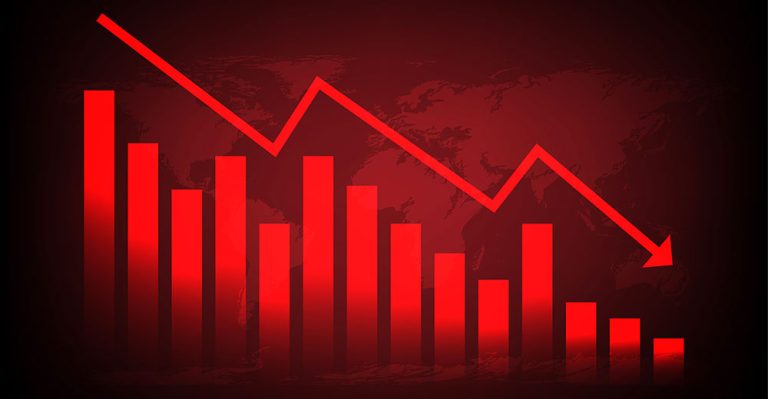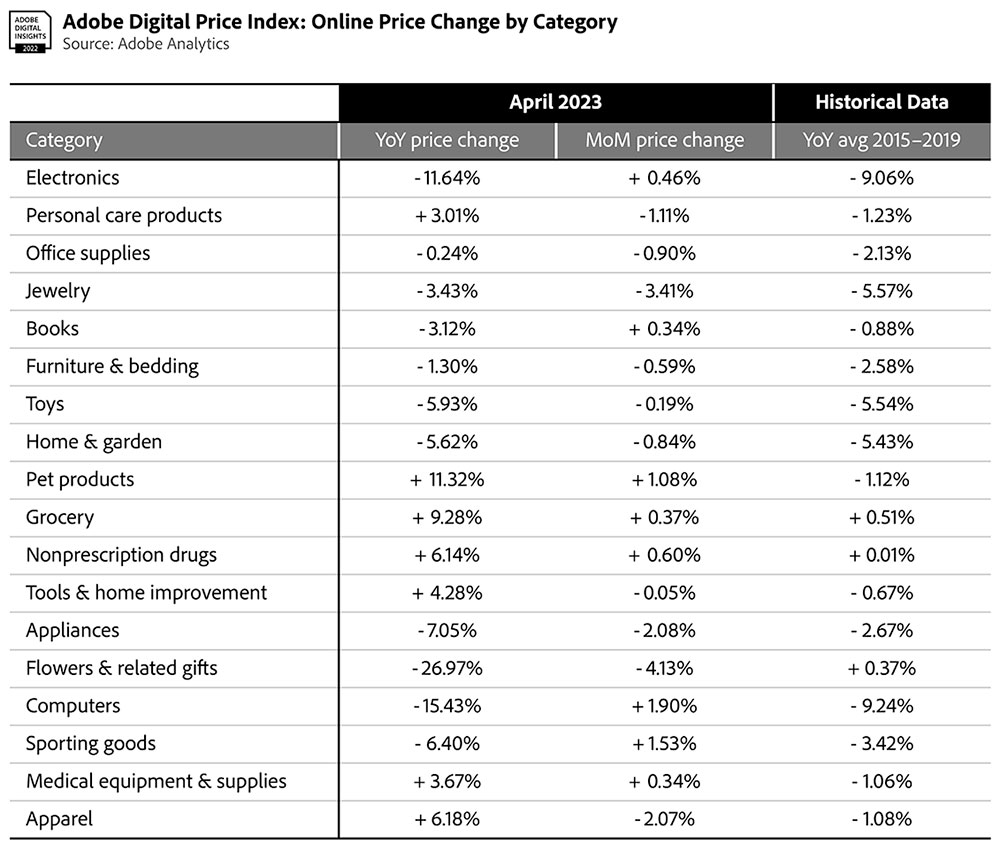
Holy deflation! For the eighth month in a row, on-line costs have declined, in accordance with the Adobe Digital Value Index, which analyzes one trillion visits to on-line retail websites and greater than 100 million SKUs.
The index for April, launched on Tuesday, confirmed a year-over-year decline in on-line costs of 1.8% and a month-over-month drop of 0.7%.
Eleven of the 18 product classes tracked by Adobe had year-over-year declines, led by computer systems with a 15.4% value drop through the interval and adopted by electronics (11.6%), home equipment (7.1%), sporting items (6.4%), toys (5.9%) and residential and backyard (5.6%).
Adobe famous that the 7.1% YoY dip in equipment costs was the biggest decline within the class because the firm started monitoring on-line costs in 2014.
A mixture of issues has contributed to sinking equipment costs, in accordance with Rob Enderle, president and principal analyst on the Enderle Group, an advisory companies agency in Bend, Ore.
“There’s been a discount in demand and, in anticipation of a recession, a discount in equipment advertising,” he advised the E-Commerce Occasions. “The consequence has been a decline in gross sales that’s being offset by value reductions.”
Decreased Demand
“We’re in a usually gradual time of 12 months,” Enderle added, “so a few of these value reductions may very well be cyclical.”
“However demand has been dropping as a result of excessive rates of interest,” he continued, “and most of those classes are discretionary and never luxurious choices which regularly endure when there’s a broad discount in demand or market downturn.”
“Increased rates of interest put a damper on credit score shopping for, which seems to be having an opposed impression on demand,” he defined. “These value drops are to mitigate that demand drawback.”
“Demand that exceeds provide is among the major drivers of inflation. One other is a rise in provider prices,” he added.
Enderle pinned the numerous decline in electronics and pc costs to excessive rates of interest and the pandemic.
“The pandemic saturated the market with comparatively new merchandise, and this market lives on churn,” he mentioned, “however, moreover, this class of product is usually bought on credit score, and with credit score prices unusually excessive, demand has suffered.”
Adobe additionally identified that the worth declines in sporting items are coming on the finish of a formidable string of value will increase.
Previous to the present 12-month value dip, Adobe famous sporting items costs rose for 28 consecutive months, beginning in January 2020. Value will increase peaked in September 2020 at 15.8% YoY, as extra customers stayed house through the Covid-19 pandemic and invested in merchandise comparable to health gear.
Bloated Stock
Value tendencies in financial staples like oil and commodities have additionally contributed to the skid in on-line costs. “If you happen to take a look at the costs for oil and different commodities, in addition to delivery prices, a whole lot of that peaked final summer season,” mentioned David Swartz, an fairness analyst with Morningstar Analysis Providers in Chicago.
“The worth of a whole lot of commodities, moreover oil, have come down. For instance, cotton costs have come approach down within the final eight or 9 months,” he continued.
“The primary half of final 12 months, delivery costs had been very excessive,” he defined. “They’ve come down dramatically since then. That impacts many classes as a result of so many issues are imported.”
“When delivery prices had been sky excessive in 2021 and 2022, that drove up inflation,” he added.
Swartz famous that there had been a slowdown in gross sales in most of the product classes tracked by Adobe.
“We’ve additionally seen a whole lot of corporations caught with an excessive amount of stock, so that they’ve needed to low cost merchandise,” he mentioned.
He cited the instance of Below Armour, which had very weak gross margins within the March quarter. “It needed to do a whole lot of discounting as a result of it was caught with a whole lot of stock,” he defined. “That’s deflationary. It brings costs down.”
“We’ve seen that in a whole lot of different classes,” he continued. “It wasn’t a very robust Christmas season, so a whole lot of corporations went into 2023 with extra stock.”
“The concept that we’re seeing deflation in some classes is no surprise as a result of we’ve seen slowing inflation in quite a few prices to retailers within the final six months,” he added.
Value Drop Resistors
Not all product classes had value drops through the interval lined by the Adobe report, most notably the groceries and private care classes.
Though grocery costs rose 9.3% YoY (up 0.4% over the earlier month), they’ve slowed up to now seven months from a peak of 14.3% YoY in September.
In accordance with Adobe, customers are more and more shopping for extra of their groceries on-line, and this class has usually moved in lock step with the Client Value Index.
Enderle maintained that prices and a mismatch of provide and demand proceed to drive excessive costs within the grocery sector.
“The chicken flu, flooding, and regional drought are all working to cut back provide whereas demand for this class stays fixed,” he mentioned. “Thus provide has dropped in opposition to constant demand leading to value will increase largely as a consequence of environmental points.”
Within the private care space, costs had been up 3% in comparison with the earlier 12 months, a lower from the earlier month when its YoY improve was 4.4% and from the worth dash it skilled in February, climbing to a YoY change of 6.1%.
Adobe famous that this class had seen persistent inflation on a long-term foundation, with solely a single month since September 2020 that noticed a year-over-year value fall. That was in November 2021, when its YoY dropped 0.9%.
“Private care merchandise are thought of non-discretionary with steady demand no matter market circumstances. That seems to be the case nonetheless,” Enderle mentioned.
“Folks will purchase private care objects frequently, even when the costs are greater,” Swartz added. “It might differ to a level, however for essentially the most half, the demand is inelastic. It doesn’t change that a lot. That isn’t the case for lots of different classes.”
Concerning the Abobe Digital Value Index
Adobe’s Digital Value Index does for on-line pricing what the Bureau of Labor Statistics’ Client Value Index does for offline costs.
Powered by Adobe Analytics, the DPI covers 18 product classes: electronics, attire, home equipment, books, toys, computer systems, groceries, furnishings/bedding, instruments/house enchancment, house/backyard, pet merchandise, jewellery, medical gear/provides, sporting items, private care merchandise, flowers/associated presents, non-prescription medication, and workplace provides.


